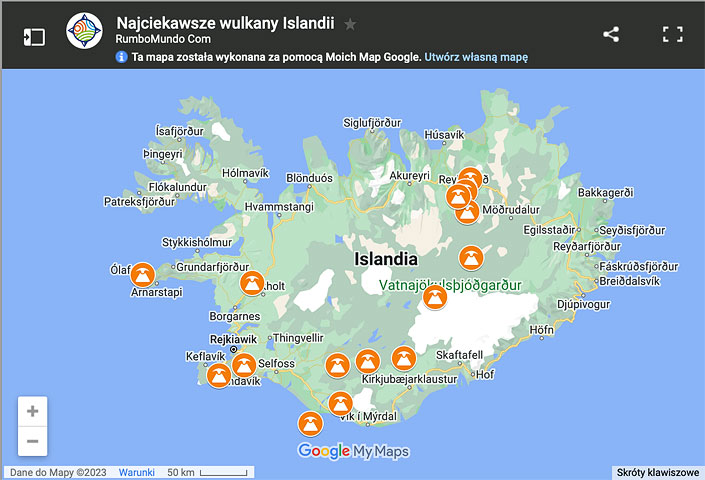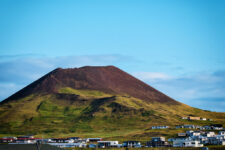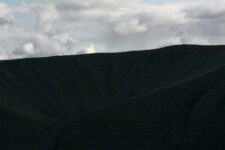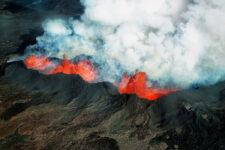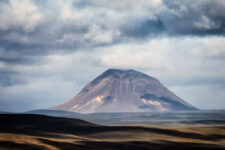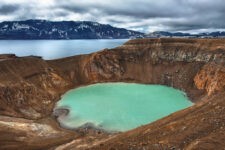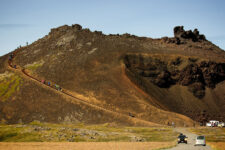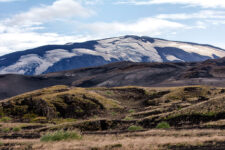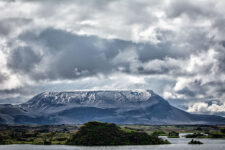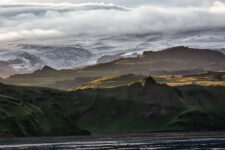There is a reason why Iceland is called the land of ice and fire. The main factor responsible for its current magical landscape and natural diversity are volcanoes, and more specifically, the volcanism of the entire island. Volcanoes (or volcanic cones) in Iceland come in many different shapes and sizes and possibly there is no other place on this Earth where we could see so clearly such a great variety of them.
Iceland’s most interesting volcanoes
Until recently, Iceland’s most famous volcano was certainly Eyjafjallajökull It was this volcano that halted air transport throughout Europe and much of the world in 2010.
In 2021 and 2022 the most talked-about eruption was Geldingadalir. It was very small and also mild, so it was possible to be observed up close. As long as fresh lava continued to flow from its fissures Geldingadalir (sometimes called Fagradalsfjall and later Meradalir) was the greatest tourist attraction of Iceland. Read more abut it here Iceland’s latest attraction – Geldingadalir eruption.
Historically, the most important were certainly Hekla and Krafla, which are responsible for some of the biggest natural disasters in the island’s history (with Hekla also erupting in the late 20th century and still remaining dangerous). Today’s largest volcano is Bárðarbunga, located under the Vatnajokull glacier, on the eastern part of the island. Its main caldera measures as much as 8 by 11 km!
However, historical momentousness is not the only criterion, and the variety of Iceland is endless and offers many – perhaps slightly less known, but very interesting – volcanoes.
Map: Iceland’s most interesting volcanoes.
So, which Icelandic volcanoes are most worth seeing? Here is our list of the top 10 Icelandic volcanoes:
Askja
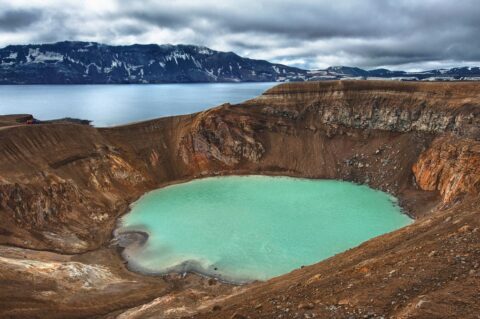
Askja – Lake Viti
Inside the Askja caldera there are two volcanic lakes: Öskjuvatn (the second deepest in Iceland) and Viti. And it is Viti that is the reason why Askja is worth visiting more than all other volcanoes in Iceland, and perhaps in the world. Well, the Viti lake (its name means Hell) is filled with warm, sulfurous water in which you can bathe! Yes, here you can take a warm bath directly in the crater of an active volcano! Wow…
Z
sure, bathing in a professional spa is more therapeutic, and in a tiny spring on the sidelines is perhaps more charming, but bathing in the volcano’s crater lake is, in my opinion, the most interesting and unusual thing you can do in Iceland, and perhaps in all of Europe (the world?). This place is not to be missed!
Getting to Askja is quite difficult, but also possible without (your own) 4×4 car. You can read about how to do it and what else is worth seeing in the area in this article: Askja – volcano with bathing area.
Hverfjall

Hverfjall
Dignified, black and beautifully located almost on the edge of a lake, Hverfjall is simply lovely. Its distinctive crater, with an almost perfect circular shape, could serve as an example for many other volcanoes. The walls of the cone are covered with graphite, almost black gravel (in fact, the entire cone consists of such “gravel” – volcanic tuff). In addition, access and ascent to the top of this remarkable volcano are very easy.
You can read more about the unusual and beautiful Hverfjall, including how to reach it and what else to see in the area, here: Hverfjall – a volcano unlike any other.
Thríhnúkagígur

Inside the Thrihnukagigur volcano
The magma chamber of a dormant volcano should be plugged with solidified lava, but in this case all the lava has flowed outward, leaving an open entrance directly into the volcano’s chamber. This allows you to take a day trip inside the volcano and admire the impressive magma chamber! You’ll go inside by elevator, whose shaft reaches as far as 120 meters down. This trip, although expensive, is worth the price and is a very interesting experience.
Thrihnukagigur – a dormant volcano with an unusual magma cave
Hekla
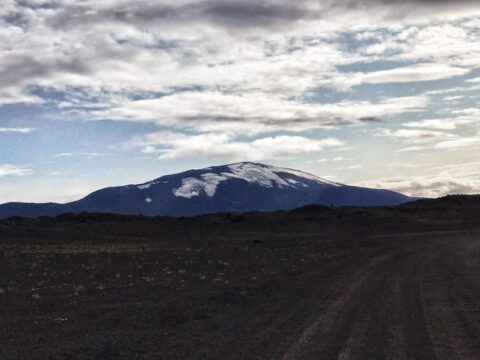
Hekla Volcano
For those without a 4×4 car, traveling on the ring road and other paved roads, Hekla is the best opportunity to see fairly up close a huge, dignified volcano with a remarkable history. Those with an off-road vehicle can drive very close or even climb the volcano. You can read more about this remarkable volcano here: Hekla – Queen of Icelandic Volcanoes.
Krafla
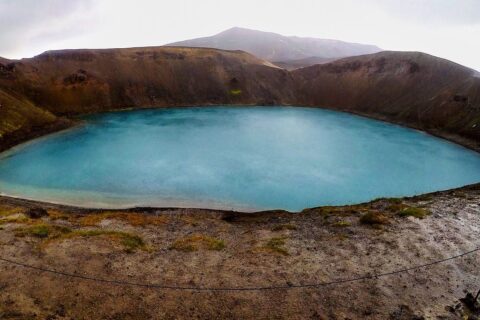
Viti Crater, with Krafla Peak in the background
Most tourists visiting Krafla take as its cone one of the spur hills located here. Meanwhile, it is just a small ‘mound’ on the crown of the volcano. In fact, Krafla is so huge that its caldera (crater) itself is about 10 km wide, and the underground chamber extends for up to 20 km around the place considered to be its center (at Viti Lake; not to be confused with the aforementioned Viti at Askja – these are two different lakes/craters).
You can read about the volcano, the lava field stretching around it and the power plant located right next to it in this article: Krafla – the great volcano near Myvatn.
Ljótipollur
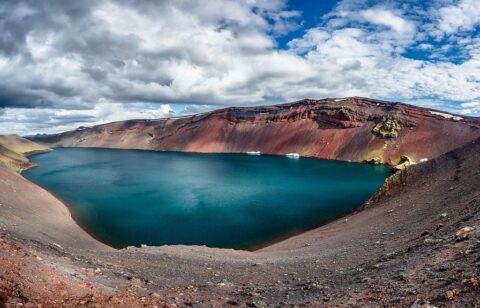
Ljotipollur (Landmannalaugar)
Although getting here is not the easiest thing to do, it is definitely worth seeing this beautiful place, despite its daunting name. Ljótipollur – Iceland’s most beautiful puddle.
For those without a 4×4 vehicle, a sure substitute (smaller, toll-free and not as spectacular) may be the very popular and advertised Kerid near Reykjavik.
Blafjall

Blafjall
The unusual and unique thing about Blafjall is that, despite the fact that it has not seen a glacier for a very long time, it is precisely the so-called subglacial volcano due to its genesis. This is a very interesting phenomenon, because such volcanoes are formed by the eruption of lava, which breaks through the covering layer of ice. As a result, the volcano takes on the peculiar shape of a table mountain – it is a solitary mountain with extremely steep slopes and a truncated, flat top. You can read more about Blafjall in an article on the classification and genesis of Iceland’s volcanoes: Blafjall (How Iceland’s volcanoes work).
Laki

line volcano – Laki
Getting to this volcano is not the easiest thing to do, it is reached via the F206 road, which requires an all-terrain, 4-wheel drive vehicle. However, it is worth the trip to the area, as the sight of a long volcanic fissure overgrown with green moss, which contrasts with the surrounding black lava terrain, is an exceptionally spectacular landscape. In addition, the route itself leading up to the volcano already offers stunning views, and its culmination is the proverbial icing on the cake. You can read more about Laki and other Isladnia volcanoes here: Laki (How Iceland’s Volcanoes Work).
Eldfell
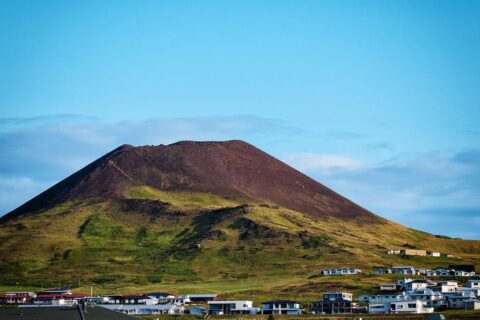
Eldfell volcano
Today Eldfell (which means Mountain of Fire in Icelandic) reigns just above the city, and a unique Eldheimar museum has been established on the land that was flooded by lava. Archaeologists in the early 21st century decided to dig up the lava-flooded houses, and to their eyes appeared a sight like from Pompeii – the houses they found looked as if time had stopped in them. They found tables set with dishes, and closets full of clothes and other things buried in them. It is this ‘innards’ of a still-living city that makes Eldfell attractive. You can read more about this volcano in an article about the entire archipelago in which Heimaey lies: Vestmannaeyjar – islands on the south coast of Iceland and in an article about the types and effects of volcanoes in Iceland: Volcanoes of Iceland (Eldfell).
Meradalir (Fagradalsfjall / Geldingadalir)
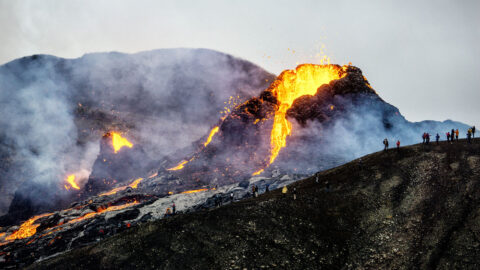
Geldingadalir/Fagradalsfjall volcano during 2021 eruption
The eruptions themselves (both the 2021 one and the 2022 one) were rather small and mild, but precisely because of that, they were also relatively safe to watch up close.
As an aside: the new eruption fissure was formed in the Meradalir Valley. The previous crater, on the other hand, was formed in the neighboring valley – Geldingadalir, on the slopes of the Fagradarsfjall mountain. Hence the eruption already serves three names….
Hiking trails have been marked out to both eruption sites, but it is a route of about 7 km, and due to the rather difficult mountainous terrain, it will take up to 4-5 hours of walking (one way!!). So it is necessary to be very well prepared for such a trip. At the same time, as of the end of August 2022, there is little interesting to see on the site, so spending a whole day on a trip to such a place seems excessive.
For more detailed information about this latest wonder of Icelandic nature and how best to visit it, see our separate article: Iceland’s newest attraction – Geldingadalir eruption.
Extra: Skútustaðagígar pseudocraters

Skutustadagigar and the famous flies from lake Myvatn
So you can read about how Skútustaðagígar were formed, where they are located and how to visit them in a separate article: Skutustadagigar – unique pseudocraters.
Extra 2: minor interesting volcanoes
In addition to the list of the truly most interesting volcanoes in all of Iceland indicated above, three more are worth noting. They are somehow not particularly spectacular, but they are very easy to visit. Therefore, if you’re in their vicinity, it’s worth stopping for a while to see them up close, even if it’s not worth going to the area specifically for them. The three volcanoes are Grabrok, Saxholl and Eldborg. As it happens, all three lie on or near the Snaefellsnes peninsula.
- Grábrók
From the crown of Grabrók you can see very clearly how the lava poured and solidified during the recent eruptions. At the same time, it is tangible proof that for Icelanders, volcanoes are a perfectly ordinary thing – they build their houses almost based on these lava outpourings…. The path that leads to Grabrok from the parking lot is easily accessible to everyone, and the view from the top is of the magnificent surrounding landscape, fancifully shaped by lava. Grabrok – volcanic crater surrounded by houses.
- Saxholl
If you’re visiting the Snaefellsness peninsula, the Saxholl is worth a look. It may not be as picturesquely surrounded, but is otherwise quite similar to Grabrok. A small but distinct volcanic cone with a convenient path to the top. Such a miniature of a large volcano, available for anyone to visit.
- Eldborg
Eldborg lies almost directly ‘at the entrance’ to the Snaefellsnes peninsula. It’s a lonely but beautiful crater; a textbook example of a spatter cone (literally, a splashed cone) crater. Unlike the previous two examples, the parking lot from which we set out to view it is not at the very foot of the volcano, but about a 2-hour walk away. However, this allows us to have a really wild volcano completely to ourselves, so if you have some free time – it’s worth coming here. More about where it lies, what it looks like and how to visit this volcano can be found in a separate article: Eldborg – an unusual crater with jagged walls.
Other articles about Iceland’s volcanoes and volcanism
The above list is just a small sampling of what can be seen in Iceland. There are many more phenomenal volcanoes and other natural wonders in this place. Virtually every mountain and larger hill is a volcano crater….
If you want to get a better understanding of Iceland’s volcanoes, their structure, division, genesis and influence on Iceland’s history and appearance, reach for these in-depth articles as well:
Photos of Iceland’s most interesting volcanoes
